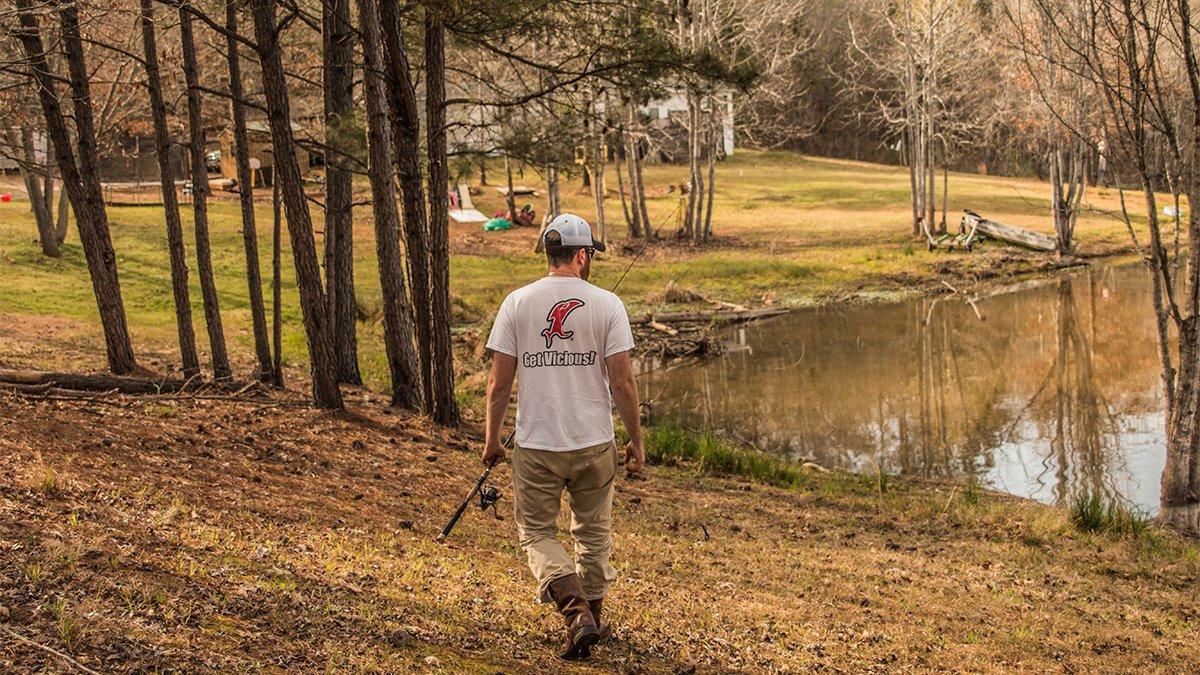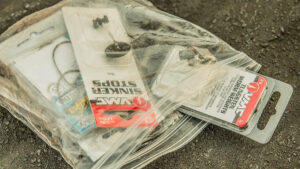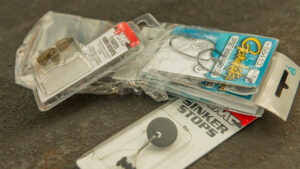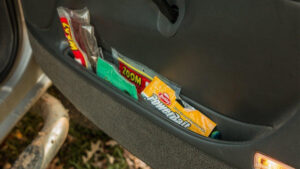Not everyone has the luxury to decide when they’re going to go fishing. Life is busy, so many of us—myself included—simply go whenever we have a few extra minutes. This is exactly why it’s important to have a fishing kit in your vehicle and ready to go at a moment’s notice.
Personally speaking, I got really tired of digging through my boat to find tackle and then transferring it all to my truck when I wanted to go bank fishing for an hour or two. The back-and-forth was driving me crazy and I didn’t have a bunch of time to waste, so I made an impromptu bank fishing kit.
This kit stays in my truck and most of it fits in a sandwich bag. Now I can hit a few ponds after work and scratch the wid-week itch without a big production.
Essential No. 1: Hooks
It sounds obvious, but hear me out: I’ve never been to a pond where the bass didn’t eat Texas rigs. So why should I bring a 10-pound tackle tray filled with a bunch of other hooks? I really simplified my hook selection process and it has made my bank fishing endeavors much less stressful.
I keep a pack of 3/0 and 4/0 Offset EWG hooks, in their original packages, in my kit. I use the 3/0 size for floating worms and stick worms, while I prefer the 4/0 Offset EWG hooks for bulkier creature baits.
Everyone has different opinions in regards to hooks, but I use these particular hooks for both pitching and long casts. I’ve never had a problem with my hookup ratio since switching to them. You can add other hooks if you need to, but I am a huge proponent of simplicity.
Essential No. 2: Small tungsten
Most ponds I’ve fished have a mucky bottom, which can make it quite annoying if you’re trying to drag a soft-plastic with a larger weight—nobody wants to pick dead leaves and other junk off of their bait between every cast. The most versatile weight I’ve found for bank fishing thus far is a 3/16-ounce tungsten.
It’s not so heavy that it’ll sink your Texas rig into the soft, mushy bottom of the pond. But it’s heavy enough that you’ll be able to make long, 45-degree casts from the bank in order to target deeper break lines and search for submerged cover such as branches and stumps.
I strongly suggest using the tungsten weights. They’re much denser than the traditional lead weights, which significantly increases your sensitivity. Bank fishing is all about the small details; you’re limited on your options, which makes it imperative to identify every piece of cover within your reach. This tungsten will make any changes in bottom composition—hotspots for good bank fishing action—very evident without any guesswork.
Essential No. 3: Pegs
Weight pegs—also known as bobber stops—are a must-have for anyone who’s fishing from shore. If you’re making long casts, you can do without them because a free-sliding weight can give your plastic more action, but you need to have ‘em if you’re pitching or flipping cover.
These pegs keep your weight in place, right above the eye of the hook. When you’re trying to penetrate laydowns or other cover, this is important because the Texas rig will slide through much easier if it’s one cohesive unit. If you try to pitch or flip with an unpegged weight, you’ll notice a lot more snags and hang-ups, which can be especially frustrating from the bank. You can’t use a trolling motor and go free your bait, so it’s important to make sure you’re doing your part to minimize snags.
They’re ridiculously cheap and easy to use, so there’s no reason not to have a pack of them in your kit.
How do you store the essentials?
Reverting back to my simplicity, I keep the above tackle in a sandwich bag. It’s not sexy and I’m sure you could use some nifty dry box or something, but heck—I found some of these baggies in my pantry and figured they’d work. I can roll up the bag, stick it in my back pocket and go fishing.
Mobility is huge. If you think your hook might be dull but you’re 300 yards away from your truck, you’re probably not going to walk all the way back to grab a new hook. If everything is in your back pocket, however, you can re-rig in a few seconds and fish with confidence.
I keep all of the tackle in its original package (all of the packages are really small) and just stick it in my truck. No more digging through your tackle for 20 minutes just to go make a few casts before supper.
Soft plastic No. 1: Floating worm
If it ain’t broke, don’t fix it.
The floating worm, such as the Zoom Trick Worm, has caught thousands of trophy bass from ponds all over the country. They work. You can fish ‘em weightless as originally intended, but you can also put a 3/16-ounce tungsten on ‘em and catch a bunch of fish on post-frontal days.
Soft plastic No. 2: Stick worm
This is another option that can be used both weighted and unweighted. Bass eat them like candy and they’re actually pretty heavy, so you can cast them easily which expands your possibilities from the bank.
Soft plastic. No. 3: Creature bait
Keep a bag or two of your favorite creature bait in your truck, just in case the other two soft plastics I’ve mentioned aren’t cutting it. They’re a little bulkier than the other options and this can be a major key when the bass are targeting bluegill in the shallows. The 13-pounder I just caught from the bank ate a Zoom Baby Brush Hog that had been in my truck for almost a year.
Color considerations
What if they’re eating green pumpkin with gold flake and not green pumpkin with red flake?
What if they want the disco ball magic but I only have the regular disco ball?
Screw it. I’ll just bring it all.
Some anglers will agonize over which soft-plastic baits they should bring on a quick bank fishing trip. How do I know? Because I used to be one of ‘em. The older I’ve gotten and the more I’ve learned, however, the more I think we totally overcomplicate things. I might sound like an old geezer here, but here’s my theory: Green or blue.
I use watermelon red if the sun is high and the water is relatively clear. The added flake puts off some extra flash and sunfish have a little red on ‘em. You can use any color flake you’re comfortable with. It doesn’t have to be red just because I mentioned it.
I use green pumpkin if it’s cloudy and the water is relatively clear. It puts off a more noticeable silhouette, so the bass can see it a little easier.
I use junebug or black/blue if I’m fishing dirtier water after some precipitation.
In my opinion, the worst thing you can do when bank fishing is overcomplicate things. It’s supposed to be a fun way to relax, so don’t make it harder than it should be.
Where do you store these soft plastics?
Again, not the sexiest answer in the world, but I stuff ‘em in the door pocket of my truck. If your significant other doesn’t like riding shotgun with a bunch of plastic, these bags can easily fit in a one-gallon plastic bag. You can keep this bag in your back seat, trunk or toolbox.
What about other lures?
There are infinite ways you can catch a bass from shore, but again, this is a quick and compact kit you can keep in your truck and use at a moment’s notice. We’re not talking specialty fishing rods and a front seat full of tackle. This is something the average working man—who works his fingers raw for just a few hours of fishing each week—can afford and have some fun with.
You’ll catch plenty of big bass on an old-fashioned Texas rig. Even if you’re able to peel off the side of the road for just 15 minutes before picking up your kid from practice, this kit will help you get that mid-week fishing fix we all need.
















